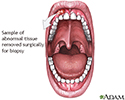Gum biopsy
Biopsy - gingiva (gums)A gum biopsy is a surgery in which a small piece of gingival (gum) tissue is removed and examined.
Biopsy
A biopsy is the removal of a small piece of tissue for lab examination.

How the Test is Performed
A painkiller is sprayed into the mouth in the area of the abnormal gum tissue. You may also have an injection of numbing medicine. A small piece of gum tissue is removed and checked for problems in the lab. Sometimes stitches are used to close the opening created for the biopsy.
How to Prepare for the Test
You may be told not to eat for a few hours before the biopsy.
How the Test will Feel
The painkiller put in your mouth should numb the area during the procedure. You may feel some tugging or pressure. If there is bleeding, the blood vessels may be sealed off with an electric current or laser. This is called electrocauterization. After the numbness wears off, the area may be sore for a few days.
Electrocauterization
Electrocauterization is the process of heating tissue with electricity.
Why the Test is Performed
This test is done to look for the cause of abnormal gum tissue.
Normal Results
This test is only done when gum tissue looks abnormal.
What Abnormal Results Mean
Abnormal results may indicate:
-
Amyloidosis
Amyloidosis
Primary amyloidosis is a rare disorder in which abnormal proteins build up in tissues and organs. Clumps of the abnormal proteins are called amyloid...
 ImageRead Article Now Book Mark Article
ImageRead Article Now Book Mark Article - Noncancerous mouth sores (the specific cause can be determined in many cases)
Mouth sores
There are different types of mouth sores. They can occur anywhere in the mouth including bottom of the mouth, inner cheeks, gums, lips, and tongue....
 ImageRead Article Now Book Mark Article
ImageRead Article Now Book Mark Article -
Oral cancer (for example, squamous cell carcinoma)
Squamous cell carcinoma
Squamous cell skin cancer is the second most common type of cancer in the United States. Other common types of skin cancer are:Basal cell cancerMelan...
 ImageRead Article Now Book Mark Article
ImageRead Article Now Book Mark Article
Risks
Risks for this procedure include:
- Bleeding from the biopsy site
- Infection of the gums
- Soreness
Considerations
Avoid brushing the area where the biopsy was performed for 1 week. You may be given a mouthwash to keep the area clean for a week after the procedure.
References
Ellis E, Huber MA. Principles of differential diagnosis and biopsy. In: Hupp JR, Ellis E, Tucker MR, eds. Contemporary Oral and Maxillofacial Surgery. 7th ed. Philadelphia, PA: Elsevier; 2019:chap 22.
Wein RO, Weber RS. Malignant neoplasms of the oral cavity. In: Flint PW, Francis HW, Haughey BH, et al, eds. Cummings Otolaryngology: Head and Neck Surgery. 7th ed. Philadelphia, PA: Elsevier; 2021:chap 91.
-
Gum biopsy - illustration
Gum biopsy is a diagnostic procedure in which a small piece of gingival (gum) tissue is removed for examination. The test is performed when examination of the mouth reveals abnormal-appearing gum tissue.
Gum biopsy
illustration
-
Tooth anatomy - illustration
The structure of the tooth includes dentin, pulp and other tissues, blood vessels and nerves imbedded in the bony jaw. Above the gum line, the tooth is protected by the hard enamel covering.
Tooth anatomy
illustration
-
Gum biopsy - illustration
Gum biopsy is a diagnostic procedure in which a small piece of gingival (gum) tissue is removed for examination. The test is performed when examination of the mouth reveals abnormal-appearing gum tissue.
Gum biopsy
illustration
-
Tooth anatomy - illustration
The structure of the tooth includes dentin, pulp and other tissues, blood vessels and nerves imbedded in the bony jaw. Above the gum line, the tooth is protected by the hard enamel covering.
Tooth anatomy
illustration
Review Date: 1/29/2025
Reviewed By: Ashutosh Kacker, MD, FACS, Professor of Clinical Otolaryngology, Weill Cornell Medical College, and Attending Otolaryngologist, New York-Presbyterian Hospital, New York, NY. Review provided by VeriMed Healthcare Network. Also reviewed by David C. Dugdale, MD, Medical Director, Brenda Conaway, Editorial Director, and the A.D.A.M. Editorial team.




